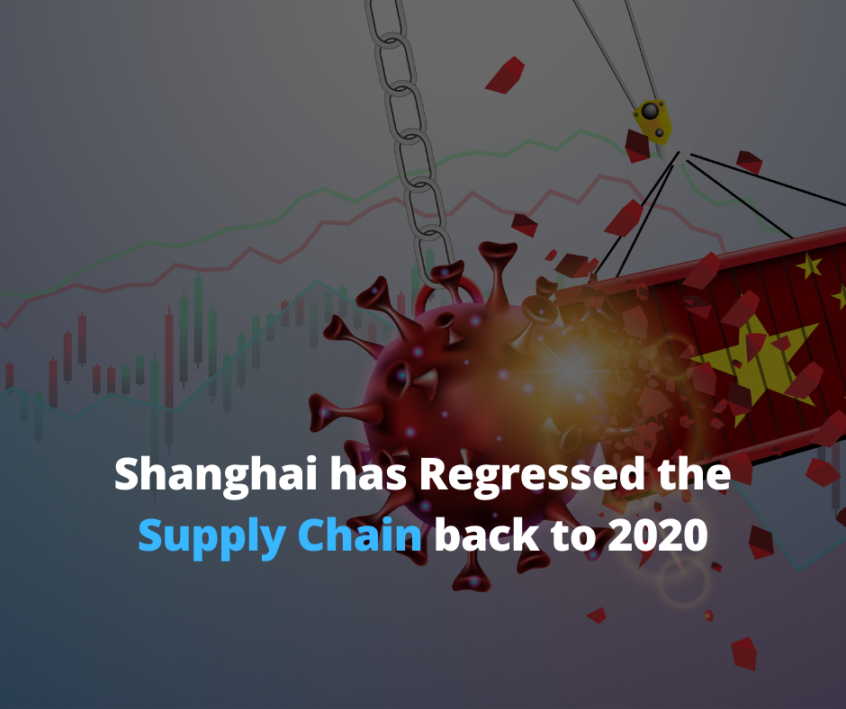
The last time the Chinese supply chain was this shaky was in 2020 at the height of the Covid-19 pandemic. As before, this disease outbreak has hit China and the rest of the world by extension. Shanghai is in lockdown to prevent further infections, but the logistics industry’s cost is incalculable.
The same effects are being experienced today, including slumping shipping rates, factory closures, and empty vessels or containers stranded at various ports. A once-vibrant ocean trade is now countenancing the possibility of blank sailings to save time and money on port delays and the resultant charges. The last three years have preoccupied the shipping industry with managing the effects of the pandemic, and this latest crisis is no different.
A pandemic containment strategy with far-reaching effects
The Chinese government has adopted a zero-tolerance policy on Covid infections, meaning that any reports of new cases can trigger a lockdown, which makes it virtually impossible for people to work. This inability to work then impacts factories that no longer have enough staff and port authorities, which are facing similar problems.
The shipping industry also pays a price in terms of a disrupted supply chain. Shanghai was the latest epicenter of the containment policy, a city home to about 25 million people. Additionally, Shanghai is the largest manufacturing and export hub in China, whose indefinite lockdown is bound to impact the entire supply chain across the globe.
Operators in the logistics business are worried about history repeating itself where there is a deceptive calm during a lockdown. Yet, removing movement restrictions means that the pent-up stock in warehouses and factors must somehow be offloaded. China was turned into a flood of US-bound and Europe-bound merchandise immediately after the initial lockdowns.
The same thing could happen again. However, there is some good news in that, unlike in 2020, China has not closed off its ports entirely. The quarantine measures have been targeting inland areas. In turn, though, it is unwelcome news for factories that produce the merchandise that turned China into a hub of international trade.
Factories whose productive capacity is severely hindered
Not only is there a shortage of factory workers, but few truck drivers are also willing to shift goods from the factory to the warehouse or the transit port. Apart from the local food panics and mass hysteria, businesses are concerned about the requirements for truck drivers to take Covid tests before being allowed to enter Shanghai. The fear of a positive test and the resultant quarantine is so strong that some drivers are avoiding entering Shanghai altogether.
Moreover, other cities seem unwilling to take in truckers from Shanghai because of the generalized assumption of infection in that area. The impact on productive capacity is also reflected in challenges for logistical capacities. For example, the Freightos container index indicates that rates have fallen by 5%, and they currently stand at $9,280 per container from March 12, 2022, to April 8, 2022.
This coincides with the time when the Shanghai lockdown started. Some of the larger routes are posting even more significant declines in rates. For example, the rate for shipping between China and Europe has declined by about 9% during the same period. Yet, some routes are experiencing a price spike. For example, the Europe-to-South America route experienced a spike of up to 10% in the last few weeks.
Although low rates would appear to be a logistical advantage, they are currently anything but advantageous. Even with the lowered rates, freight forwarders cannot take advantage if they cannot get the merchandise from the warehouse onto a ship. Thus, given the lack of cargo, some shipping lines are announcing even more blank sailings from Asia.
This is understandable since data released on April 8th indicated that the volume of goods shipped out of Shanghai had fallen by more than a quarter between March 12th and April 4th of 2022. Similarly, the volumes of goods leaving the port by truck had fallen by nearly 20% during the same period. Logistics companies are being forced to engineer imaginative solutions to these latest challenges.
The impact of the lockdown on the logistics sector
Some logistics professionals believe that there will be an upsurge in demand for shipping once the lockdown is eased and factories re-open. However, such an event will create new pressures on the shipping industry to oversee the influx of cargo waiting to be shipped. There is expected to be a shortage of containers at various ports in China, in the short term at the very least.
Typically, that means that prices will rise again. Ultimately, the supply chain will have to contend with yet another disruption after its tentative steps toward recovering from the ravages of the Covid-19 pandemic. The race to halt the spread of Covid-19 has other effects on transportation, including clogging highways and many factory workers being stranded at home. The contagion of the omicron variant has made it increasingly challenging to procure materials for manufacturing, let alone shipping out merchandise.
Companies like Foxconn Interconnect Technology are struggling, a Taiwan-located unit of the brand specializing in manufacturing connectors and equipment. It has kept a plant in Kunshan on the borders of Shanghai. Using a closed-loop approach, this company can barely manage its typical operations. Nevertheless, the latest reports indicate that Foxconn-Taiwan is only operating at 60% capacity.
Up to 30 Taiwanese companies specializing in electronic parts have indicated that the outbreak of Covid-19 in Eastern China and the resultant lockdowns have forced them to shut down for at least a week. For example, Bosch (a German auto parts dealer) has suspended production at its plants in Changchun and Shanghai. Two other plants are now under closed-loop operations.
Similarly, Pegatron Corp, which specializes in the assembly of Apple iPhones, has temporarily stopped operations in Kunshan and Shanghai. Unless the lockdown eases soon, these stories are bound to be repeated. The pain will not only be felt in Shanghai but across the globe, especially in the logistics and shipping sectors.
Wrapping up
The new outbreak of Covid-19 in China has triggered the zero-tolerance policy of containment in Shanghai. This is a key city and ocean shipping hub in China. The resultant lockdowns have meant factory closures and transportation challenges with staff not coming to work.
Because of China’s global strategic importance to the shipping industry, there are far-reaching consequences on global trades, such as fluctuating rates. Even when the restrictions are eased, there will likely be a backlog of inventory needing to be shipped. This will likely create even more chaos to the logistics and shipping industry that has already been ravaged by the effects of the Covid-19 pandemic.



One Comment on ““The Crisis in Shanghai has Regressed the Supply Chain back to 2020””
thank you for sharing this important and unique content.It’s really a good website for getting a nice knowledge.